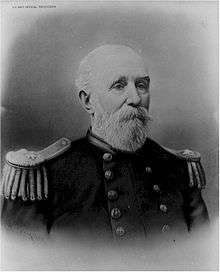Thomas Phelps
| Thomas Stowell Phelps | |
|---|---|
 Rear Admiral Phelps | |
| Born |
November 2, 1822 Buckfield, Maine |
| Died |
January 10, 1901 (aged 78) New York City |
| Place of burial | Arlington National Cemetery |
| Allegiance |
|
| Service/branch |
|
| Years of service | 1840–1884 |
| Rank | Rear Admiral |
| Commands held |
USS Corwin USS Juniata |
| Battles/wars | |
Thomas Stowell Phelps (Buckfield, Maine, 2 November 1822 – New York City, New York, 10 January 1901) was an officer in the United States Navy. He served in the United States Navy from 1840 to 1884, attaining the rank of Captain in 1871 and Rear Admiral in 1884. He served in the Mediterranean, the Atlantic, and the Pacific, and commanded the sloop Juniata during the critical battle to capture Fort Fisher in January 1865.[1]
Service prior to the Civil War
Phelps was born in Buckfield, Maine. He joined the Navy in 1840. He served on the Labrador Coast and then with the Mediterranean Squadron from March 1840 to September 1843. He then served aboard the sloop Boston in the Brazil Squadron. He was assigned to the United States Naval Academy in October 1843 and graduated in February 1846.[1]
He rejoined Boston for duty as a member of the Gulf Squadron from October 1846 through February 1847, and then served aboard the Polk from February to May 1847. After duty aboard the Independence, the flagship of the Mediterranean Squadron from June 1849 through December 1850, he transferred to the Constitution and served in the Mediterranean Squadron from December 1850 to February 1851. He then served in the Coast Survey from May 1851 until August 1852.[1]
He served in the Indian War in Washington Territory. While serving on the Decatur, he was active at the Battle of Seattle which took place on 26 January 1856. In 1882, he wrote Reminiscences of Seattle: Washington Territory and the U. S. Sloop-of-War "Decatur" During the Indian War of 1855-56[1][2]
Action during Civil War
When the American Civil War began, Confederate forces destroyed or sabotaged many navigational aids in the Potomac River. Phelps was called on to use his experience conducting coastal surveys to chart the Potomac River. He was part of the expedition sent to relieve Fort Sumter and assisted in secretly surveying and marking the Confederate coast. He later conducted a secret survey of Virginia coastal waters and was recognized by the Secretary of the Navy for his efforts.[1]
In September 1861, he was transferred to command the steamer Corwin and surveyed and buoyed Hatteras Inlet in preparation for Union incursions into the inlets and rivers, along with other coastal inlets. His ship engaged the Confederate gunboat CSS Curlew in Hatteras Inlet on 14 November 1861, and skirmished with gunboats in Pamlico Sound.[1]
He engaged the Yorktown and Gloucester Point batteries, sunk two Confederate vessels, and prevented Confederate forces from destroying White House Bridge during April and May 1862.[1] Phelps was promoted to lieutenant commander in July 1862 and was charged with surveying and charting coastal waters for blockades and navigational purposes. He commanded the sloop Juniata during the successful attack on Fort Fisher, which had been protecting blockade runners' vital access to the Confederate port at Wilmington, North Carolina until it was captured by the Union on 15 January 1865. This was the last supply route open to Robert E. Lee's Army of Northern Virginia.[1]
During the Battle of West Point on 16 April 1865 in West Point, Georgia, he prevented a large force of Confederate forces from joining with their main army.[1] In 1865, he was commissioned commander, promoted to captain in 1871, to commodore in 1879, and rear admiral in 1884, and retired in 1885. Phelps died in the Naval Hospital in New York City on 10 January 1901 and was buried in Arlington National Cemetery (Section 1 grave 504).[1]
Family life
He married Margaret Riche Levy. They had one son, Thomas Stowell Phelps, Jr. (1848–1915), who also attained the rank of rear admiral, and a daughter, Edmonia Taylor Phelps (1858-1909), who married Theodorus B. M. Mason. Mother, father and son are buried in adjacent plots in Arlington Cemetery.[1] The destroyer USS Phelps (DD-360) was named for him.
References
- 1 2 3 4 5 6 7 8 9 10 11 "Thomas Stowell Phelps, Sr. Rear Admiral, United States Navy". arlingtoncemetery.net. 19 November 2006. Retrieved 21 September 2009.
- ↑ "Reminiscences of Seattle: Washington Territory and the U. S. Sloop-of-War Decatur During the Indian War of 1855-56". history.navy.mil. Seattle: The Alice Harriman Company. 1908. Retrieved 2 October 2006.